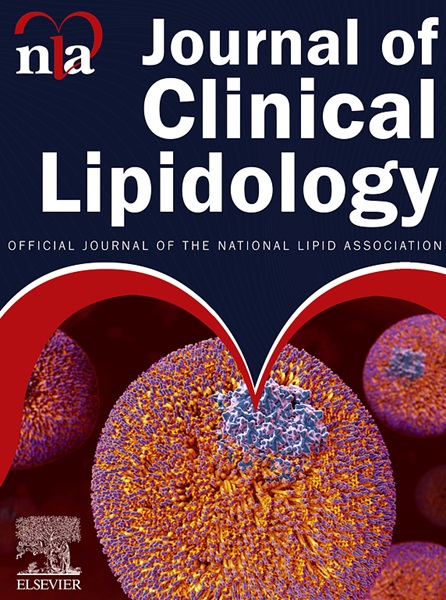降脂策略与颅内动脉瘤风险之间的因果关系:药物靶点孟德尔随机化研究。
IF 4.6
3区 医学
Q2 PHARMACOLOGY & PHARMACY
引用次数: 0
摘要
背景:观察性研究表明,不利的脂质特征与颅内动脉瘤(IAs)的发生之间存在潜在的相关性,这表明降脂治疗可能会抑制IA的进展并防止其破裂。本研究旨在探讨降脂策略对IAs风险的因果影响。方法:我们使用3种遗传工具作为我们暴露的代理,并使用FinnGen生物银行的结果全基因组关联研究数据评估因果效应。与低密度脂蛋白胆固醇(LDL-C)、高密度脂蛋白胆固醇和甘油三酯密切相关的单核苷酸多态性,位于靶基因区域±100 kb内,被选为药物靶孟德尔随机化(MR)的工具变量。此外,利用双样本MR (TSMR)和基于汇总数据的MR (SMR),进行基因表达和蛋白质MR分析,从转录和翻译的角度阐明脂质水平的因果关系。结果:药物靶MR分析显示,蛋白转化酶subtilisin/ keexin type 9 (PCSK9)抑制介导的LDL-C降低与IA发生风险增加相关(OR = 1.406, P = 3.28E-09)。相比之下,蛋白MR显示较高的PCSK9表达对IA发病率有保护作用(ORTSMR = 0.896, P = 1.79E-03;Orsmr = 0.881, p = 1.78e-02)。亚组分析进一步表明PCSK9可降低IA破裂风险(ORTSMR = 0.893, P = 1.08E-02;Orsmr = 0.866, p = 3.39e-02)。结论:我们的MR分析表明,PCSK9的高表达与IA形成和破裂风险降低之间存在潜在的因果关系,突出了PCSK9抑制剂在脑血管疾病中的双重作用。因此,在处方PCSK9抑制剂时需要仔细考虑,特别是在有发生IAs风险的患者中。本文章由计算机程序翻译,如有差异,请以英文原文为准。
The causal association between lipid-lowering strategies and risk of intracranial aneurysms: A drug-target Mendelian randomization study
BACKGROUND
Observational studies have suggested potential correlations between unfavorable lipid profiles and the occurrence of intracranial aneurysms (IAs), proposing that lipid-lowering therapies might curb IA progression and prevent rupture. This study aimed to explore the causal impacts of lipid-reducing strategies on the risk of IAs.
METHODS
We employed 3 genetic tools as proxies for our exposures and assessed causal effects using outcome genome-wide association study data from the FinnGen Biobank. Single nucleotide polymorphisms strongly associated with low-density lipoprotein cholesterol (LDL-C) and high-density lipoprotein cholesterol, and triglycerides, located within ±100 kb of the region of target genes, were selected as instrumental variables for drug-target Mendelian randomization (MR). Additionally, gene expression and protein MR analyses were conducted to elucidate the causal effects of lipid levels from transcriptional and translational perspectives, using two-sample MR (TSMR) and summary-data-based MR (SMR).
RESULTS
Drug-target MR analysis revealed that proprotein convertase subtilisin/kexin type 9 (PCSK9) inhibition-mediated LDL-C reduction was associated with an increased risk of IA development (odds ratio [OR] = 1.406, P = 3.28E-09). In contrast, protein MR demonstrated that higher PCSK9 expression had protective effects against IA incidence (ORTSMR = 0.896, P = 1.79E-03; ORSMR = 0.881, P = 1.78E-02). Subgroup analyses further suggested that PCSK9 might reduce the risk of IA rupture (ORTSMR = 0.893, P = 1.08E-02; ORSMR = 0.866, P = 3.39E-02).
CONCLUSION
Our MR analyses indicated a potential causal relationship between higher PCSK9 expression and a reduced risk of both IA formation and rupture, highlighting the dual role of PCSK9 inhibitors in cerebrovascular disease. Hence, careful consideration is warranted when prescribing PCSK9 inhibitors, particularly in patients at risk for developing IAs.
求助全文
通过发布文献求助,成功后即可免费获取论文全文。
去求助
来源期刊
CiteScore
7.00
自引率
6.80%
发文量
209
审稿时长
49 days
期刊介绍:
Because the scope of clinical lipidology is broad, the topics addressed by the Journal are equally diverse. Typical articles explore lipidology as it is practiced in the treatment setting, recent developments in pharmacological research, reports of treatment and trials, case studies, the impact of lifestyle modification, and similar academic material of interest to the practitioner.
Sections of Journal of clinical lipidology will address pioneering studies and the clinicians who conduct them, case studies, ethical standards and conduct, professional guidance such as ATP and NCEP, editorial commentary, letters from readers, National Lipid Association (NLA) news and upcoming event information, as well as abstracts from the NLA annual scientific sessions and the scientific forums held by its chapters, when appropriate.

 求助内容:
求助内容: 应助结果提醒方式:
应助结果提醒方式:


